Monday 29 June 2009
Too Much Puppy Food?
 Can I feed my puppy to much?
Can I feed my puppy to much?
There is a false idea with large-breed puppies that since they have larger bones, they need more calcium and more calories to continue developing at the rapid growth rate puppies experience. This is not true. Many large-breed puppies that experience too rapid of growth in their first six months experience developmental bone problems. The best plan of attack to prevent these issues in your large breed puppy is to control the rate of growth by controlling their intake of calories, calcium, and phosphorous.
If you are overfeeding your puppy, their high weight makes them at even higher risk for bone problems. You should be able to feel the dog’s ribs, but not see them. If you can not feel your puppy’s ribs, this is an indicator that you are over-feeding or should switch to a lower calorie diet. Many puppy foods are rich in calories; which is why many kennels switch to adult dog food at around 12 weeks to safely promote growth. If you feel your puppy is ready to make the switch, make sure you are feeding an adult dog food appropriate for all life stages. Follow these guidelines and your puppy will experience normal skeletal development.
Monday 8 June 2009
Stopping a Jumping Dog
Unless given a command to jump, a dog should never be allowed to jump on humans. A dog who jumps on a human at his own free will is a dog who does not respect the person he is jumping on. Even those cute little toy dogs should not be allowed to jump on people. While you, the owner, may think it is cute, it is not cute to everyone else. Not only is it annoying to most people to have someone else's dog jump on them, it can also be dangerous. A jumping dog can knock people over and muddy their clothes, put runners in nylons and scratch.
When a dog jumps on a human at their own free will they are not "greeting" the human, they are asserting their dominance on them. It is the dog communicating that he is alpha and or wishes to own or control the human. A subordinate would never dream of running over and jumping on the alpha dog of the pack. Space is respect and lower remembers of the pack respect the higher members. If your dog jumps on humans he does not respect them.
I remember going to a dog park where a little 4 month old Boxer puppy ran around and jumped up on everyone. The dog was not heavy enough to knock most of the adults down, however, he left everyone with muddy pants and was big enough to knock over small children. The owner did nothing to stop the jumping puppy. After all, it was just a small pup. Everyone around her was pretty annoyed at the muddy prints the dog was leaving all over their clothes. That is an owner who will have a problem with their dog jumping on people when he gets older.
Puppies should be told from day one, "no jumping". Anything you do not wish your cute little puppy to do when he is full grown should not be allowed when he is a puppy. Think about the behaviors you allow your puppy to do; is it something you will always allow him to do even when he is full grown? If the answer is no, do not allow your puppy to do it from day one.
Dogs like and need consistency, so if you are not allowing your dog to jump on you, everyone in the family and everyone who greets the dog must do the same. You, as an owner, must make sure this happens. It will only confuse a dog if you allow him to jump on some people who say they do not mind, and tell him not to jump on others. Once you decide you do not wish your dog to jump on people you must apply this to everyone at all times unless you give the dog a command to jump. A dog should never jump on a human at his own free will.
Stopping the Jumps
To a dog, space and balance is very important. If you take a step backwards or lean out of a jumping dogs way, the dog will continue to jump. To a dog, space means a lot and the dog will be gaining space. When a dog jumps, step into "your space". Picture a sphere around you. A sphere of your space and you are not going to allow anyone or anything to come into your space. When the dog jumps, step into it sideways with your body, shoulder towards the dog. Don't face the dog head on. You are not trying to knock the dog down, you are simply calmly filling up your space with your body, and in return, setting the dog off balance, which is an uncomfortable feeling for a dog. Lean slightly forward, not backward. Never lean backwards, as you will be giving the dog that space. Casually and calmly, keep filling your space, not allowing room for the dog to come in. Remember, your goal is not to knock the dog down or walk into the dog, it's just to fill your space. You may end up bumping into the dog in doing so, however, do not make that your goal, keep the goal on protecting your space.
You can do this with any dog who jumps on you, take a sideways step forward just as the dog starts to jump, filling the space the dog was about to take up. This will throw off the dogs balance and at the same time, claim your space. You will earn respect from the dog and soon, the dog will learn it is no fun to jump on you.
© Dog Breed Info Center® All Rights Reserved
Recognizing Dominate Behaviors in Dogs
List of dominate behaviors which can occur in dogs (This list is not yet complete)
Besides the obvious guarding, growling and biting many dogs display a variety of dominant behaviors that commonly go unrecognized by their humans. Dogs very rarely display the highest level of dominance overnight. There are usually signs leading up to it over the years and dominate alpha dogs do not always growl and bite. If the owners are giving the dog what they want there sometimes is no reason for the dog to growl or bite unless they are challenged. Dogs understand that they exist in a human world. After all, who gives them food and opens the door for them to go potty? When humans perform these tasks on demand from the dog though, why wouldn't the dog think they're the leader? It is easy for dogs to get the impression they are alpha in their pack. Since many canine alpha behaviors are not acceptable in human society, for example biting being one of the alpha communication tactics it is important for humans to remain the leaders over their dogs.
Below are some common behaviors dogs display when they believe they are above humans. Keep in mind that a dog does not have to display all of these behaviors to be in a dominant frame of mind. Sometimes an alpha dog will only display a few of the behaviors and at random times, depending on what the dog decides they feel like doing at any given moment. Smarter dogs tend to challenge the pack order more then dogs of average or below average intelligence.
Stubbornness
Headstrong and willful
Demanding
Pushiness
Begging
Pushing a toy into you in order to get you to play with them.
Nudging to be pet.
Sitting in high places looking down on everything.
Barking or whining at humans which many owners consider "talking" (without a command to do so).
Jumping or putting their paws on humans (without a command to do so).
Persistence about going in and out doorways before humans.
Persistence about walking in front of humans while on a lead.
Not listening to known commands.
Dislikes people touching their food.
Standing proud on a human lap.
Persistence about being on top, be it a lap or stepping on your foot.
Persistence about where they sleep, i.e. on your pillow.
Annoyance if disturbed while sleeping.
Likes to sleep on top of their humans.
Licking (giving kisses) in a determined and focused manner.
Caring themselves with a proud gait, head held high.
Not liking to be left alone and getting overly excited upon the humans return. (See Separation Anxiety in Dogs)
To learn more about dog psychology and what makes a dog tick, we strongly suggest Cesar Millan DVD's and or Cesar Millan Books to every dog owner, from Chihuahua to Pit Bull
. An excellent guide to
Small Dogs vs. Medium and Large Dogs
(Small Dog Syndrome - Dog believes he is the pack leader to humans)
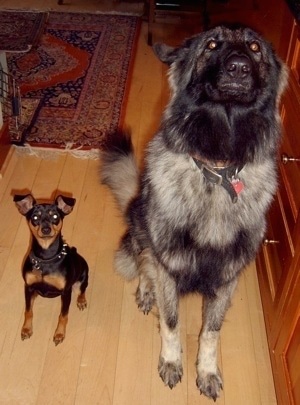
Are you one of those people who prefer larger dogs? Do you know someone who has told you that they prefer larger dogs because small dogs are yappy and snappy? Whether we are a large dog person or a small dog person, one thing we all would agree on, is the larger percentage of small dogs tend to have a different type of temperament than medium and large dogs. Small dogs have earned the reputation of being yappy, snappy, jealous, protective, wary of strangers and not the greatest child companion and, unfortunately, it has become widely accepted. Similar to the myth that Pit Bulls are all vicious fighting dogs whose jaws lock and they will not let go until their prey is dead. That's just the way some small dogs are. Right?
I received a package and my two Boxers went over to greet the UPS driver. I called the dogs back and the driver explained he didn't mind saying hello to my dogs. He could tell they were friendly, then added.... "It's those small dogs you have to watch out for."
So why do little dogs tend to act differently than large dogs? They are all the same type of animal, a mammal of the Canidae family, of the order Carnivora: Canis lupus familiaris, which is a domesticated subspecies of the wolf. Commonly referred to as a canine. This type of animal has instincts that need to be fulfilled in order for the animal to be happy and balanced. Let's take a closer look at how we treat large and medium dogs, as opposed to how we treat small and toy dogs.
Many behaviors we humans do not allow large dogs to get away with we find cute in small dogs. For example:
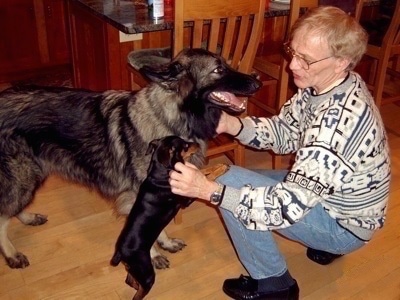
Jumping
If an 80-pound German Shepherd jumps up on a human, everyone agrees that this behavior needs to be corrected. Everyone sees this as a problem and the owners would seek help from a trainer, and/or read up on it on the Internet to remedy the behavior. At the very least, the dog would be locked in a separate room when guests arrived to protect the guests from getting hurt.
Now picture a little 8-pound Miniature Pinscher jumping up on a human. You look down and I’ll be darned, it's kind of cute. It does not hurt and people think "The dog likes me!"
But what does it really mean? If dogs were human this would be true ... but they are not. Jumping has a totally different meaning to a dog than it does a human. It's a dominancy and respect issue. For a dog, space is a sign of respect and when you allow your little dog to jump on a human you are allowing them to disrespect a human. You are allowing them to display pack leader behaviors.
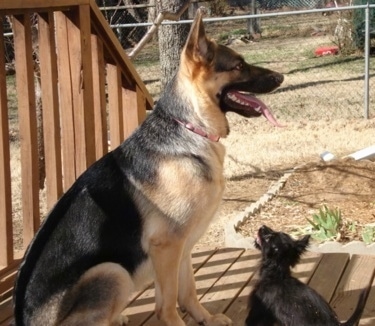
Sadie, the 70-pound GSD, with Rudy, a 4-pound Chorkie.
Growling
If a German Shepherd were to growl at your guest, you and your guest both know there is a problem. Something has to be done. However, if that tiny 6-pound Chihuahua growls, well it's just what he does. He's a Chihuahua, right? Wrong... There is no difference, in a dog’s mind, for a German Shepherd to be growling at a human than there is for a Chihuahua. It's just another behavior we humans let those tiny dogs get away with.
Other Dogs
If your little 5-pound Yorkshire Terrier decides to bark and growl at another dog while you are walking down the street, or as another dog passes by your house, it's almost seen as cute, because you see it as your tiny dog thinking they are a big dog. However, if your 120 pound Akita barks and growls at another dog, the dog is more likely to be put in their place and told to stop. The fact is, dogs should never be allowed to display dominant behaviors. Whether it be a huge or tiny dog, their pack leaders (humans) should tell the dogs "NO" and follow through until the dog understands this is not an acceptable behavior. And for the record, dogs do not "think" they are either big or little. They live in the moment and are just what they are, reacting to the moment. To dogs, size means nothing.
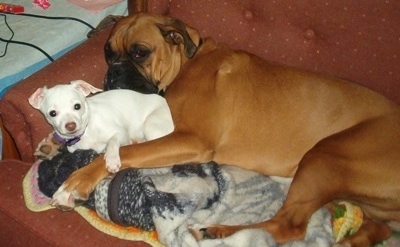
Roxanna the Boxer laying down with Miya, the Jack Chi hybrid.
Space
If you were eating dinner or working at your computer and your 70-pound Boxer comes running over and jumps up on your lap, chances are you would knock them back down telling them "No, not now, I am busy". However, if that 5-pound Maltese jumps up on your lap, well it's just cute. He loves you and just wants to be on you. There's that space issue again. Pack leaders decide when and where to do things. The pack leader belongs on top. It is ok for your little lap dog to sit on your lap. However, it has to be at times when YOU invite them.
Claiming the Human
If you are sitting down watching TV on the couch, your little dog can jump up next to you on the couch, so long as your dog understands it is your couch, not theirs. You need to make your dog wait until you invite them to climb into your lap. When a dog makes it a habit of jumping up on a human at their own free will, we humans see it as love and affection. However, to a dog it is a claim. The dog is trying to own you. So the next time you notice your dog is adamant about being on you, remember, he is claiming you not loving you. The human needs to claim their own space back and the dog must be told they can only climb on top when the human invites them.
If you feel your dog is jumping on you in an "I own you" way, it is best not to put nor knock the dog on the floor. Rather, use your fingers to bite her off (poking with enough intensity to make the dog react by moving). You need to communicate with your body language until they move off of the person by themselves. Make them move off; do not physically move the dog. When you see the dog settling down into a calm submissive state, (head down low, not making eye contact, ears back, tail relaxed and not tucked in, not rigidly high), then it is ok to invite them on you, if that is what YOU want. However, if the dog once again gets in an "I own you" stance, they need to be moved off again. Making the dog move, not by you moving the dog. The dog needs to be the one physically moving off.
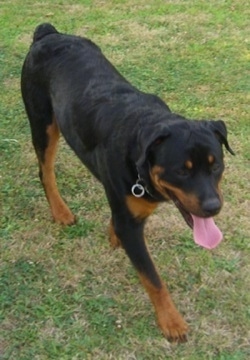
Jeremy, the Rottweiler.
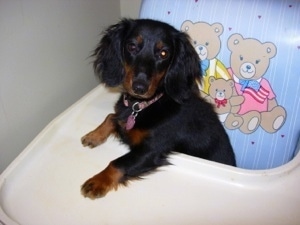
Francis, the Long Haired Miniature Dachshund.
Aggression
If your 120-pound Rottweiler decided to viciously bark at your housekeeper... you KNOW you have a problem. However, if your tiny little Dachshund does it, you inform the housekeeper to avoid the dog. The little dog may hide under the table barking and growling, is told to be quiet, but the correction is never really followed through on. The houseguest is told to not put their hands under the table. However, if this were a Rottie, the behavior would be addressed. Small dogs are more likely to be allowed to display dominant behaviors that should never be accepted.
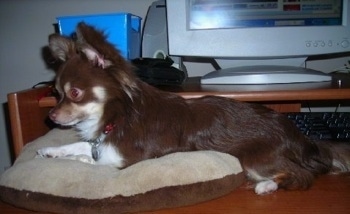
Prince, the longhaired Chihuahua.
Lap Dogs
Ever see a small dog jump up on its owners lap and growl at anyone who comes too close? The owner feels the dog is "protecting" them "because they love me". When actually the dog is "Claiming" "THEIR" property. Talk about allowing a dog to be alpha. Now imagine a Doberman Pinscher on that same person's lap, snarling if someone comes to close. Picture in your mind going back and forth, Chihuahua on their owner's lap growling... Doberman Pinscher on their owner's lap growling.
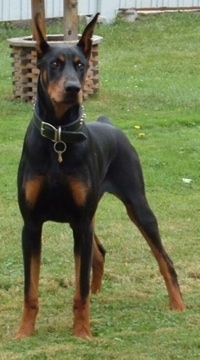
Romeo, the Doberman Pinscher.
Chihuahua, Doberman.... Chihuahua, Doberman... While it may seem less of a big deal for the Chihuahua to display this type of dominate behavior IN A DOG’S MIND there is no difference between a Chihuahua doing this and a Doberman Pinscher or German Shepherd exhibiting this behavior. Yet a large percentage of small dogs are allowed to display this behavior.
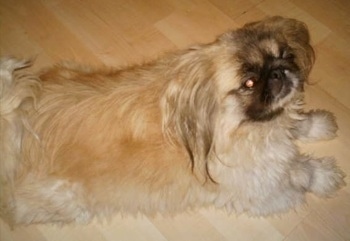
Luna, the Pekingese.
Walks
If someone were walking a 7-pound Pekingese and they were pulling on the lead as hard as they could to get near a tree to pee on it, most dog walkers would simply hold the lead and allow the dog to pull way out in front. What's the harm? The dog is not strong enough to knock a person down and you know you have a good grip on the lead, right?
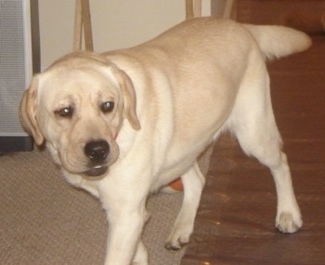
Chanel, the Labrador Retriever.
Whereas if a 70-pound Labrador Retriever were pulling you as hard as they could, there is a good chance they may just drag the human across the pavement. Large dogs are more likely to be told to behave on a lead than little dogs. However, even most large dogs do not walk properly on a lead. Most dogs (large and small) take their owners for a walk (in front of the human) when they should be beside or behind them (pack leader goes first). Large dogs are, at the least, mostly taught not to pull. Whereas not only do small dogs walk out in front, they also pull without being corrected. Dogs who act very excitedly when their humans come home are showing signs of a lack of exercise and/or leadership. For a dog, excitement does not indicate happiness. In most cases, it is a sign of an unbalanced state. When you come home after being gone, avoid speaking to your dog in an excited manner. If we see dogs has human, a dog not being excited and happy does not make sense. However, we must remember dogs are canines, not humans.
How about those sleeping arrangements?
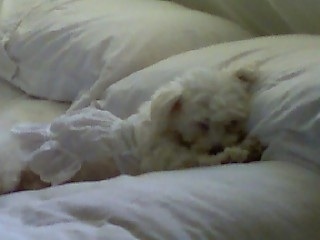
Bella, the 7-pound Malti-pom, "She's very quiet, and refuses to sleep at the end of the bed, she wants her head on the pillow, and her body under the covers right in between us!"
Large and medium size dogs are less likely to be allowed to sleep at the top of the bed next to a person's pillow. There simply is not room for both human and a large dog. If a large dog is allowed on the bed, they will often be told to sleep at the foot of the bed. Small dogs are more likely to be allowed to sleep right on a human's pillow. In the dog world, the pack leader sleeps in the highest (height wise) most comfortable place. And for those very tiny dogs who cannot jump on the bed themselves, they get to bark and TELL THE HUMAN when to put them on the bed and when to take them back off the bed. In a dog's mind only the pack leader tells others what to do. It is not necessarily a bad thing to allow your dog to be on your bed, so long as YOU are deciding when they can get on the bed and when they need to get down. Just keep in mind in the dog world, the pack leader sleeps in the most comfortable spot; so do not allow your dog to push you out of your spot. Your dog needs to lie around YOU, not you around THEM.
The Yappy Trait
While some dogs have more of a tendency to get yappy. The yappy traits have everything to do with the way they are treated by the owner. For instance, if the dog lacks a pack leader and feels THEY are the pack leader they may become yappy every time you leave them alone. Or become yappy as they try to get YOU to follow THEIR commands.
If you fall into the "Small Dog Syndrome" and allow a dog to take over the home, they will tend to be more yappy. Small dogs who see their humans as 100% pack leader and are told to hush when they do bark, get daily walks and are content with themselves are less likely to be little yappers.
The Nervous Trait
When a dog appears scared, nervous, stressed, or otherwise upset in any way, we humans tend to pet them, stroke their coat, and talk to them in a soothing manner. We tell them everything is ok. We do this with both large and small dogs, but we tend to do it even more with the smaller dogs. We pick up the little dog and cuddle them every time they look upset. We humans feel good about giving this type of comfort. It's human nature and our little dogs are our babies.
This type of reassurance works on humans, it's what humans do and we understand this type of comfort. However, when the canine animal is in an unstable state of mind and is given a human consolation (treated like a human) it intensifies the dog's state (stress, fear, nervousness etc.). In the dog world when a dog is in an unstable state and you try to reassure them by giving affection, the dog sees you as being in a weaker state than their own. The canine species can read human energy. They read sympathy as weak energy. With their primal instinct to have order in their pack, it is very disturbing for a dog in a weak state of mind to be surrounded by other weak pack members. At these times there is no pack leader and chaos is present as no one is providing direction. The same is true in ALL human societies. That is why leaders are elected or allowed to be in place. It intensifies the dog's instability, sometimes to the point where the dog, in their already unstable state, tries to be your pack leader. In the dog's mind you are now weaker than they are, which instinctually puts the dog in a higher alpha position than you. Instinct tells a dog that the stronger member is higher in the pack order. This ensures the packs survival. You need to give off a stronger, more stable energy that the dog can feed from.
Many little dogs suffer from instability due to their likelihood of being babied and over protected. When large dogs are upset, since we cannot pick them up, they are less likely to be treated in this manner.
Separation Anxiety
Dogs who believe they are the pack leader often develop separation anxiety. Followers are not allowed to leave the pack leader but pack leaders can leave the followers.
List of dominate behaviors which can occur in dogs (This list is not yet complete)
Besides the obvious guarding, growling and biting many dogs display a variety of dominant behaviors that commonly go unrecognized by their humans. Dogs very rarely display the highest level of dominance overnight. There are usually signs leading up to it over the years and dominate alpha dogs do not always growl and bite. If the owners are giving the dog what they want there sometimes is no reason for the dog to growl or bite unless they are challenged. Dogs understand that they exist in a human world. After all, who gives them food and opens the door for them to go potty? When humans perform these tasks on demand from the dog though, why wouldn't the dog think they're the leader? It is easy for dogs to get the impression they are alpha in their pack. Since many canine alpha behaviors are not acceptable in human society, for example biting being one of the alpha communication tactics it is important for humans to remain the leaders over their dogs.
Below are some common behaviors dogs display when they believe they are above humans. Keep in mind that a dog does not have to display all of these behaviors to be in a dominant frame of mind. Sometimes an alpha dog will only display a few of the behaviors and at random times, depending on what the dog decides they feel like doing at any given moment. Smarter dogs tend to challenge the pack order more then dogs of average or below average intelligence.
Stubbornness
Demanding
Pushiness
Begging
Pushing a toy into you in order to get you to play with them.
Nudging to be pet.
Sitting in high places looking down on everything.
Barking or whining at humans which many owners consider "talking" (without a command to do so).
Jumping or putting their paws on humans without a command to do so.
Persistence about going in and out doorways before humans.
Persistence about walking in front of humans while on a lead.
Not listening to known commands.
Dislikes people touching their food.
Standing proud on a human lap.
Persistence about being on top, be it a lap or stepping on your foot.
Persistence about where they sleep (i.e. on your pillow).
Annoyance if disturbed while sleeping.
Likes to sleep on top of their humans.
Licking (giving kisses) in a determined and focused manner.
Carrying themselves with a proud gait, head held high.
Not liking to be left alone and getting overly excited upon the humans return. (See Separation Anxiety in Dogs)
Conclusion
The bottom line is; small dogs are no different than large dogs. What gives them their different temperaments is that humans treat them differently. We over protect them and treat them like babies. Things we do not allow large dogs to do which are common pack leader issues because of the dogs size are addressed. These are issues all dogs need to have addressed, yet the smaller dogs tend to not get this discipline.
If you are unsure how to gain control back from your dog, or if you think you are at risk of being bitten, please hire a professional to help you before you give your dog to a shelter. This commonly sentences them to Death Row. This will (or at least should) cause you to feel remorse and guilt that you will have to deal with (to varying degrees) for the rest of your life.
To learn more about dog psychology and what makes a dog tick, we strongly suggest Cesar Millan DVD's and or Cesar Millan Books to every dog owner, from Chihuahua to Pit Bull
. An excellent guide to
Saturday 6 June 2009
Speaking Dog. What's your dog saying?
One of the most common mistakes owners can make with their dogs is to misread what the dog is saying into something completely different. We humans do it all of the time. The dog's body language says one thing, and we interpret it into something completely different basing our assumption on what we ourselves are feeling. When in reality dogs see and read the world much different than we humans. If we humans better understood our dogs we could prevent many dog bites and other behavioral issues.
Dogs and Hugs
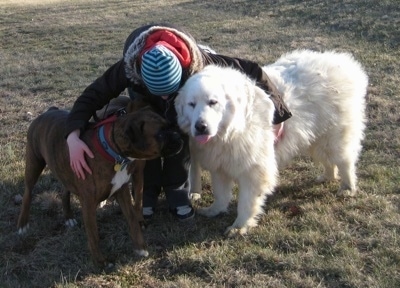
For example lets take a simple act of a hug. To humans a hug means love and affection. When a human receives a welcomed hug from a loved one it makes us feel good inside.
But just what does a hug mean to a dog? Humans are always hugging their dogs and when we do we are giving the dog affection and sharing our love. However what most humans do not realize is to a dog a hug is not affection at all. To a dog a hug symbolizes a social status ranking representing dominance and an invasion of space. Lower members of the pack give space to the higher members as a show of respect. The position of the body is also meaningful to a dog. The one on top represents a higher status ranking. Therefore when you bend down and wrap your arms around a dog you are not only on top, but you are in their space.
Keeping this logic in mind, it makes total sense to not run up and hug a strange dog. Many children are bit every day by hugging dogs and if you look at it from the dogs perspective who would blame them? A stranger comes running over asserting dominance on a dog they have just met and the dog's reaction is to communicate to this being that they do not wish to be dominated. Unlike horses and deer who are "flight animals", a dog is a "fight animal" and will communicate his displeasure with a growl, and or a snap or bite.
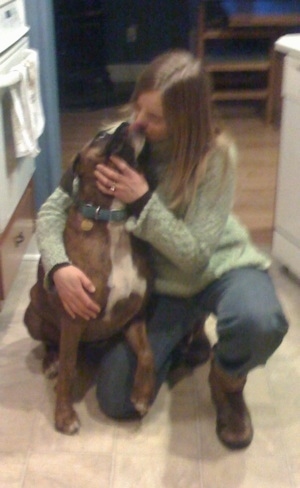
That being said, it is not bad to hug a dog that is familiar with you if the dog is calm and in a submissive state of mind, so long as you are hugging them at a time when you are relaxed and happy. As a matter of fact the emotional sensation it gives the humans to hug can be felt by the dog, and that energy radiating from the humans can be very calming to the dog. Not because he is enjoying the hug, but because he is enjoying the calm he feels coming from you.
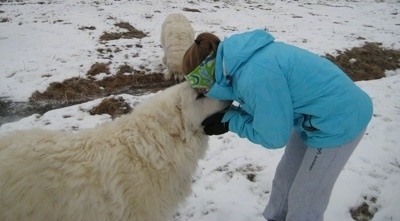
I watched a little girl come running over to a dog, giving the dog a huge hug. The little girl was overjoyed. You could tell she just loved dogs. I watched the dog's face. The dog's eyes were wide and he went somewhat stiff, as he turned his head up toward the being who was wrapping his arms around him. I saw him flick his tongue in a nervous way. While this dog did not bite this child it was clear the dog was not enjoying it. Had the child been hugging a more dominate dog the dog just may have snapped at her.
I then watched the child hug a second dog. The second dog was Bruno. Bruno lowered his head and allowed himself to be hugged. He, like the first dog, also flicked his tongue, but in a different way. His tongue came all the way out and back in as he tried to lick the child. His lick was submissive where as the first dog's lick was nervous. Bruno enjoyed the attention. He is just about as submissive as they come and enjoys any attention from any human he can get.
When you allow your children to hug strange dogs you are taking a gamble in the dog's reaction. Not even the owner can always predict what the dog's reaction will be. The proper way to greet a dog is to turn your body sideways, no eye to eye contact and allow the dog to smell you. That is greeting a dog in dog language in a non-confrontational way.
Human Interpretation
Here is another good example of how we humans assume our dogs have the same emotions and feelings as we have and put our own interpretations into a dogs reactions. This is a YouTube clip of Bonnie Hunt and her interpretation of this baby crawling over to the dog. Notice the emotion the clip draws from the human. The talk show host assumes the dog was bonding and acknowledging in a heart felt loving kind of way. The host is so moved by what is in that clip that she looks like she could cry. Overwhelmed with joy about what she believes is an emotional tie between the baby and the dog.
A lot of humans are going to watch this clip and attach their own emotions to what THEY interpreted the dog was feeling at the time the dog touched the baby back with his paw. But what is the dog really communicating? Is he overwhelmed with emotion because the cute little baby crawled over and connected with him? No, not at all. When the baby first crawled over and touched the dog's paw the dog sat up and looked to see what was touching his foot. Saw it was the baby. The dog then seeing it was the baby submitted by laying his head down. When the baby touched the dog's paw this submissive Boxer saw it as a game and was playing with the baby. But there was no heart felt emotional tie in the dog's mind like the announcer read into it. There was no strong feeling of affection felt by the dog when the baby touched his paw. The dog did not touch the baby back to show his reciprocated love. It was just a gentle game. The dog was playing. One thing we can all agree on is this clip is adorable and that Boxer is a very good dog.
When Bruno is laying down and I start to touch his feet he'll do the same. Start to move his feet because he thinks its a game we are playing. Not because he is emotionally connecting with my touch. Here is a clip where I touch Bruno's foot with a clothes hanger. Bruno sits up. When I touch his front foot he paws at it much like the Boxer who put his paw on the baby's hand.
Space
I often hear people state that when they correct their dog for a bad behavior the dog sulks, leaves the room or turns his head because the dog is "upset". The humans interpret this behavior as the dog's feelings are hurt. They feel bad and believe they need to go and "make up" with the dog.
What is the dog really saying? If you correct your dog and he turns his head or leaves the room he is giving in to you and accepting you as his leader. Giving space or turning away from direct eye contact are submissive behaviors. When humans try and "make up" with a dog after the dog has given in to you, it sends confusing mixed signals to the dog.
These examples are just the tip of the iceberg. Humans misread their dogs on a daily basis and on a wide scale of issues. I can't even imagine what it is like for a dog to be constantly misread and how confusing it must be for them. Most dogs do not wish to be the leaders, do not wish to run the show. They only wish to be secure with their pack and clearly know their status. However, they will take over when they do not see the humans as stronger then themselves. We humans would do our dogs a huge favor by trying to better understand them rather than just assume they are just like us.
and or Cesar Millan Books to every dog owner, from Chihuahua to Pit Bull
. An excellent guide to
Written by Wow Dogs
Thursday 4 June 2009
Choosing The Perfect Puppy Names - Find A Special Name For Your Special Puppy
So you're looking for a cool puppy name for your cheeky new housemate. No doubt you are searching for some inspiration and ideas so you can come up with a puppy name that is unique and befitting of your new little friend. You want a name that perfectly suits your individual dog and does him/her absolute justice.
There are so many things to consider and take care of when preparing for the arrival of a new puppy. First you have to choose the most suitable breed of dog, then find a reputable breeder and most importantly pick out the little puppy who will become your lifelong companion. It doesn't stop there... Once home you will need to provide all the basic puppy supplies, socializing your puppy to the world becomes an urgent priority and then of course you will need to get stuck into some early puppy training.
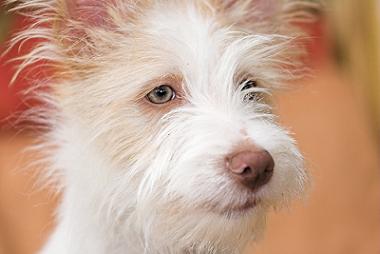
"The puppy name you decide on says as
much about you as it does about your dog."
One of your most important (and fun!) decisions when you get a new puppy is to come up with a funky name - but where do you begin to search for that perfect puppy name?
A popular way to find a name for your puppy, that is both appropriate and memorable, is to look through the extensive online databases listed below. These are sure to give you some great puppy name ideas and maybe even some inspiration to make up your own.
Puppy Names - Check Out These Huge Databases Of Dog Names
Female Dog Names
Click on the link above for a huge range of puppy naming ideas. You'll find heaps of cool female dog names, cute dog names, all the popular dog names, girl dog names and lots more! You can't help but be inspired by these great resources!
Male Dog Names
Click on the link above for heaps of ideas for male puppy names. You'll find a huge resource of popular boy dog names, favorite puppy names and unique boy dog names. Best of luck finding a brilliant name for your male puppy.
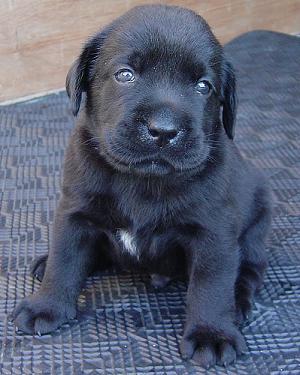
Regardless of which puppy name you come up with, your pup will need plenty of guidance, socialization and puppy training in order to become a trusted and well behaved member of the family. To help guide you through the various puppy training stages I recommend you follow this comprehensive puppy training resource - Secrets To Dog Training. This package will take you step by step through the puppy house training process, preventing problem behaviors and right through to advanced obedience training commands.
Some other pages you may be interested in:
How To Choose A Dog Breed - Choose a puppy that is just right for you and your lifestyle.
Choosing A Puppy Out Of The Litter - Things to consider when selecting your little puppy out of a litter.
How To Train Your Puppy - Covers all the basic puppy training issues.
Dog Supplies - Online Store - Need some dog supplies for your new puppy?
Perfect puppy name
Tapping Into Your Dog's Ability...
Through Dog Agility Training
Is your dog the star of the dog park? Does he move like a speeding bullet? Jump like a jackrabbit? Does he make the cute poodles drool and the show-offs look like fools?
Whether you can attribute this energy level to his breed type or to his personality, if he’s got it, he’s got to use it. You can choose to commit to giving him plenty of outdoor play time, or...you can make the most of that inherent ability...by involving him in dog agility training.
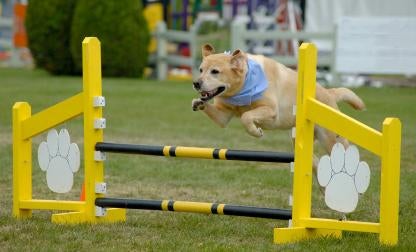
Dog agility. It’s more than a growing trend. It’s an outlet for your dog’s natural, instinctual habits. It’s a timed event, consisting of a roadmap of several obstacles, which your dog is asked to negotiate in a particular order, without fault, and under a judge-determined time limit. The pressure is on!
Think about what you know about your dog’s ancestors’ behavior. In the wild, dogs are required to chase and kill prey, and to also avoid being the prey. Imagine pursuit of a rabbit, for instance. That rabbit, when chased by a hungry canine, will hurdle rocks, slip under fallen logs, teeter on natural bridges, climb sheer slopes, and squeeze through brambles and thick brush. And if that dog is hungry, he’ll be required to do the same. Considering the hardy survival of the canine population in the wild, we can deduct that they’ve been considerably successful in chasing those quick little guys. Because they’re good at it!
Here’s another thought. Humans are also designed to be agile. Your ancestors sprinted from saber-tooth tigers, traversed rushing rivers, zigzagged through dense forests, and chased food of their own.
So, as you may guess that I’m going to suggest...why not join your dog in a rewarding sport that plays into all that’s natural and necessary..exercise, entertainment, satisfaction? All wrapped into a fast paced and elegant demonstration of adrenaline-fueled teamwork..in dog agility trials.
The History of Dog Agility
As with many of the most innovative and useful inventions, dog agility’s birth was rather unintentional. At London’s famous Crufts Dog Show in 1978, a horse-enthusiast was charged with entertaining the crowd between events. He designed a spectator event that employed dogs, doing equestrian-like feats. It was a hit, and came to the States in 1986, under the title of the U.S. Dog Agility Association. It was so much fun that it has become the fastest-growing dog sport in history.
Is your Dog an Athlete?
Or Would He Rather Just Take a Seat?
I hate to create an exclusive club here, but as with most sports, certain types are more conducive to success. Generally speaking, if your dog is descendant from a working breed, and is of medium build, then his chances of doing well are greatly increased. Among the best breeds for dog agility training are: Terriers, Shepherds, Collies, Retrievers, Sheepdogs, Spaniels, Poodles, Schnauzers, Cattle Dogs, Pinschers, Corgis, Canaans, Malinois, Papillons, and Tervurens. Mixed breeds are accepted by all dog agility clubs, except for the AKC.
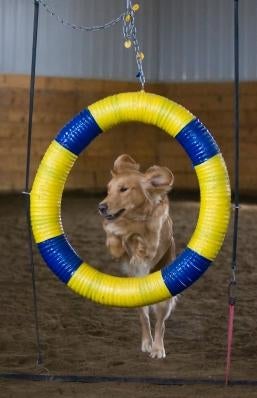
Some breeds are definite underdogs when it comes to agility training. Giant breeds like Great Danes and Mastiffs usually have neither the energy nor the desire to participate. Short-nosed breeds like Boxers, Bulldogs, and some Terriers have difficulty with activities that require heavy breathing. Breeds with short legs, like Dachshunds, can have a hard time clearing the jumps.
Age can also be a factor to consider. Puppies are excluded from trials until they reach 9 months of age, and it’s recommended that dogs older than 8 years of age enjoy their retirement – work free.
As we discussed earlier, a lot of your dog’s ability will be determined by his personality and energy level. Don’t loose heart...if you’ve got a snorer, a giant breed, or a little shrimp...remember that no breed is excluded from dog agility trails. If your kid’s got heart, then give it a shot. On the other paw, if your guy would rather lie on your lap and not break a pant, he may be better suited to a low-impact sport – the spectator type.
Benefits of Dog Agility Training
You’ve probably gathered, by now, from the information contained in my site, that almost any food, activity, or pastime that adheres to a canine’s natural lifestyle (as in that of his ancestors) is best. Agility enhances all of your active dog’s inherent abilities, plus one added element – YOU. So, that means it’s doubly beneficial – because it caters to the natural order for you and your pooch.
Once you begin, and continue to improve upon, your dog’s agility training, you’ll notice that he’s more alert, vigorous, and confident. His problem-solving capabilities will multiply. The attention that you require from him will strengthen his bond with you, reinforce basic obedience commands, and improve his communication ability. The physical demands of the dog agility courses will hone his coordination, increase endurance, and improve his overall health through physical fitness. And all of that exercise will improve his behavior off the course – because as we all know – a tired dog is a good dog.
And, yes, as for you...all of the above benefits apply. Go ahead, read the list again – it’s practically guaranteed!
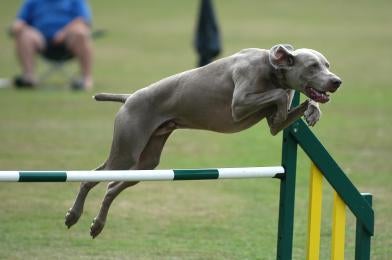
Are you Ready, Freddy?
Versed Things First
How’s your dog’s vocabulary? Is he well-versed in basic obedience commands? If your dog consistently obeys standard commands such as sit, stay, down, heel, etc., then you may be ready to embark upon the agility express. If your dog isn’t confident in you and the commands that you use, he’ll never trust you when you ask him to enter a dark agility tunnel. Yikes!
Besides your dog’s vocabulary, his physical maturity needs to be a consideration. Dogs must be a minimum of 9 months old to compete, but that doesn’t mean that every dog is ready at 9 months. Consider this: If your dog’s breed is expected to reach its maximum weight at under 50 pounds, then he won’t be finished growing until he’s 9-12 months old. Likewise, breeds that are expected to tip the scales at over 50 pounds aren’t likely to finish their upward pound-climb until they reach 10-14 months of age. Keeping this in mind, asking a puppy to clear regulation-height agility jumps before he is finished growing is a risky endeavor. His joints can’t handle that kind of trauma. Jumps higher than a growing puppy’s shoulder should remain out of the question. But, by all means, grounded equipment, like tunnels and boards, can be tackled as soon as the basic commands are mastered.
Dog Agility Training is no Gravy Train
Maybe you’ve watched an agility trial, and you and your dog are both anxious to compete. The adrenaline, the competition, the...slow down, Fido. Experts maintain that most dogs will need 6-9 months of daily, committed training before they’re ready for the real thing. And it really is a journey - a very rewarding one at that.
Bond with your dog in a playful atmosphere. Use toys to play fetch, tug-of-war, or Frisbee to reinforce commands and bring home the idea that work can be fun for your dog. You wouldn’t join your first fitness club and sign up for the advanced class on the first day. Similarly, your dog needs to work up to his best physical condition. Gradually introduce equipment, one piece at a time, in the form of short agility tunnels and low jumps. With time and continual success, tunnels may be lengthened and bars raised to regulation level. This will not only build your dog’s fitness and difficulty levels at a manageable pace, but will prevent injury and frustration.
Establish commands specific to each piece of equipment. This will be helpful when directing your dog in the ring (you’ll have the map of the course, he won’t). Also make sure that he’s confident in commands to indicate fast, slow, right, left, up, down, heel, away, etc. to keep him on course. Reward good progress with treats and lots of love. Never reprimand for missed jumps or other fumbles. If you do, your dog will quickly become frustrated and want to give up. And, remember, if your dog approaches obstacles with his head or tail down, or if he shows any reluctance at the sight of the agility equipment, then it’s not fun, and it may not be the thing for him.
Your veterinarian should always be a partner in your dog’s health. Before beginning agility training, have your dog’s joints, heart, lungs, and eyes checked. Additionally, extra weight can hinder his performance. A little belt-cinching may be in order, and your veterinarian can offer the best food plan for your little chunk.
If you like group support and good advice (who doesn’t?), then look up a dog agility club in your area. You may also be able to find a trainer that specializes in agility training. Always keep it fun. Never focus on the prize, but rather, on the special bond that you will establish with your fun-and-fitness partner.
Don’t Let Sub-Standard Equipment be an Obstacle to Success
Would you train for a marathon without running shoes? Or study for a spelling bee without a dictionary? Well then, you certainly can’t ask Spot to be ready for an agility trial unless he’s already familiar with the equipment. Likewise, if the equipment that you’re using to train doesn’t meet Dog Agility Standards, you will be sabotaging your dog’s performance under the lights. Specialized retailers sell, and specialized trainers use, standard agility equipment. You may also build your own, as long as you’re certain that it conforms with the Agility Standards put forth by the Agility Association with which you’ll be competing.
Here, I’ve included an overview of some of the most popular agility training equipment / obstacles and their descriptions:
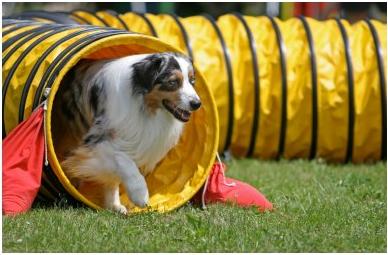
Tunnels:
Rigid tunnels consist of a wire frame, covered in vinyl. They are tubular in fashion and remain open for their entire length. They generally have the flexibility to be stretched out in a straight or curved line. Standards usually call for a tunnel 10-20’ in length, 24” in diameter.
Collapsed tunnels are constructed with a rigid, tubular entrance. Connected is an 8-10’ fabric trailer, which the dog must push his way through.
Seesaw:
A seesaw, or teeter-totter, is constructed using a plank, attached and perpendicular to, a center support pole. The plank is weighted on the entrance side so that it will automatically return to the starting position. The dog enters on the lowered side. As he reaches the center of the plank, his weight will cause the plank to shift, like a seesaw, and he will walk down, and off the exit side.
Dog Walk:
A dog walk is built using one center plank, 4’ from, and parallel to, the ground. Two other identical planks serve as the entrance to and the exit from this center plank, mounted at opposing angles from it to the ground. All 3 planks are to be 9-12” wide and 8-12’ long.
Pause Table:
The pause table is just that – a table on which the dog pauses. It can be any 3’x3’ table or platform, 8-30” from the ground (differs per height class). The dog jumps onto it and lies down for 5 seconds.
Pause Box:
A pause box is used just like a pause table, except that it is simply a 3’x3’ square marked off with tape or other material on the ground.
Jumps:
A tire jump is built by supporting or suspending a tire from a frame. The dog must jump through without touching the tire.
Not a high jump, the broad jump is made by adjoining low platforms on the ground.
The single jump is constructed of two vertical side bars, with one adjustable horizontal bar for jumping over.
The double jump is fashioned after the single jump, but rather consists of 2 sets of vertical supports, placed one set in front of the other, with horizontal bars mounted at differing heights.
Additionally, the triple jump is built using 3 sets of vertical supports and horizontal bars, at varying depths and heights, much like stair steps.
Finally, a panel jump also uses vertical supports, but rather than a bar for jumping, a solid, removal panel is utilized. Panels of varying heights are used for different height classes.
A-Frame:
A-Frames are constructed from 2 planks, placed at upright angles, to form a rough “A” shape. Each plank is 8’-9’ long and 36” wide. They are hinged at the top, where they meet. Contact zones of 36-42” are required on the entry and exit sides, and grips or ridges are necessary to help the dog in navigating up one side and down the other.
Weave Poles:
Weave Poles are upright and fixed in a straight line, 20” from one another. The dog must weave in and out of the 3’ tall poles, in a zigzag fashion, entering with the first pole at his left shoulder.
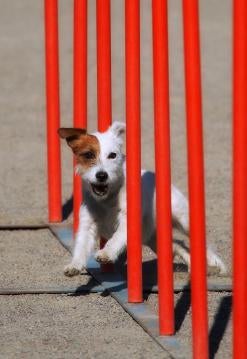
Solid, standard, equipment is essential to your dog’s agility trial success. If he’s inadvertently injured on sub-standard obstacles, he will be skittish and fearful of ever mounting that apparatus again. If he shows up to a trial and is introduced to foreign equipment, he will be unable to perform. Set him up for success. By purchasing, renting, borrowing, or building quality benchmark equipment, you will elicit a performance of equal excellence.
An Array of Agility
Just like dog biscuits...dog agility courses come in a variety of flavors. Levels are cumulative. You’ll start as a novice, on a simpler course, and move on to more difficult courses, if you choose to do so. Here are some of the more well-known types of agility courses:
Standard Agility:
This type of courses generally consists of 15-22 obstacles, of varying types – contact, tunnels, weave poles, jumps, etc.
Jumping:
Jumping agility courses contain mainly...you guessed it...jumps. There are no contact obstacles, though a few tunnels and/or weave poles may be tossed in.
Power & Speed:
The Power part of this course is a sort of pre-qualifier. If the dog is able to navigate the course without any faults (untimed), he will then be permitted to enter in the timed trial (test of speed).
Juniors:
Junior...as in the handler, not the dog. If you are under the age of 18, you and your dog can compete in this category to win medals or rosettes. Within this agility class, levels range from beginner to senior, and build in difficulty and number of obstacles.
Teams:
Two handlers with two dogs, or three handlers with three dogs are each responsible for completing a portion of a standard dog agility course. A baton is passed, much like in an all-human relay race.
Gamblers:
Gambling is not for the beginner or under-confident team. The first half of the course is run in a sort of freestyle, where the handler pre-determines the obstacles that the dog will navigate, and the order in which it will be performed. When the judge indicates time, the dog must then switch to a pre-determined course order, much like standard agility. The big challenge here...the handler cannot run alongside the dog! He or she must stay behind a line and give commands from a distance.
Snooker:
Sharpen your pencils, folks. This course will test your mathematical skills. On the course, you’ll find jumps, consisting of three red ones, all numbered “1”. There are also 6 others, numbered “2” through “7”. The dog must begin by jumping a red one, then any other non-red jump. Then another red...and so on. The numbers on the jumps are then added up to determine the final score. As with Gamblers, there is an opening and a closing portion.
Of course, each Dog Agility Association’s rules vary, and not every one is offered through every organization. And, there are undoubtedly more courses available that are unique to each association. Do your homework – find an organization that is active in your area. Talk to local pet supply retailers, trainers, and shelters for more information.
Running with the Big Dogs
Before attending your first dog agility trial, there are a few things that you’ll need to have in order. First, be sure that your entry fee is paid in full – well in advance of the deadline. Be certain that you and your dog are completely confident with every obstacle. Run them as if you were at competition, then, when trial day comes, there will be no nasty surprises for your dog.
By now, you should have familiarized yourself with the standard agility equipment used by the association of your choice, and you should know what rules will be imposed during the trial. Surprises are never a catalyst for success.
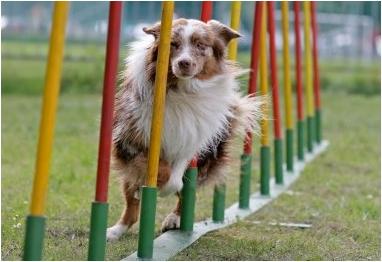
Ready...Set...Go!
Oh, your dog is looking good. He’s clearing the jumps with ease, weaving like a pro, and his new slim, trim figure has all the girl dogs drooling. You’ve made all of the arrangements for your first agility trial. So now...what to do once you get there?
Know your organization. No leniency will be provided for misunderstanding. Disqualification is inevitable if rules are broken – excuses will not be accepted.
Plan to arrive at the site of the trial at registration time, not your run time. It’s conceivable that your run time may be changed, and it’s always helpful to your agility career when you have extra time to spend with professionals, helping out and learning from them. Take along whatever your dog needs to be comfortable while he’s waiting for his big moment. A safe crate and his favorite doggy toy can go a long way toward making him feel at home. Food and water are also musts. Take some time to play, so that he’s not brimming over with blinding energy, and some time for rest, so that he’s alert.
Agility courses generally cover about 180 linear yards within a 10,000 square foot area. You will have the opportunity to assess the course before trial time. Showtime will be the first time your dog sees the course, however. No treats, toys, or leashes are permitted in the ring at trial time. You may escort your dog to the start line on a leash, but it must then be abandoned.
Your dog will enter agility trials at the Novice level (a.k.a. Starter or No Title). As he accumulates Q’s, or Qualifying Runs, he will be able to move onto the Open and Elite categories. He will earn a “Q” if he completes a run under the judge-determined Standard Course Time (SCT), without a single fault. Any of the following are considered a fault:
- Any part of the dog touches any part of a jump (obvious if a bar is knocked from the jump).
- The dog exits a piece of equipment without touching the contact zone with at least one paw.
- The run goes over the SCT.
- The handler makes contact with any equipment.
- The handler makes contact with the dog.
- The obstacles are taken out of order.
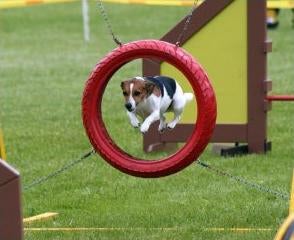
- If the dog soils the agility ring.
These are somewhat standard, but remember, each association’s rules are unique.
No matter your dog’s category, skill level, or association affiliation, one concept rings true for all agility participators. RELAX. Have fun. For your dog, this trial is just another run in the park, another practice in the back yard. Don’t let nerves get the best of you – so that the crowd, and the judges, can see the best of your dog.
Porch Potatoes Need not Apply
Every dog is special. Maybe yours is a sports star. Or, maybe he’s more like the manager, or the water boy...or the disinterested spectator. No matter, it’s important to find an activity that fits your boy or girl to a tee. Every dog needs a job – likes to feel needed and necessary. When you’ve got one that exhibits everything necessary for dog agility training, you’re going to have one happy tail-wagger in that ring.
So, tap into that natural ability. Go for agility!
Dog Tricks - Cool Dog Tricks To Teach Your Dog
Welcome To The Dog Tricks Zone - This Is
The Most Fun You Will Ever Have With Your Dog!
Teaching dog tricks is one of the greatest joys of having a canine companion in your life. Dog trick training is the best way I found to truly interact with my dogs and it is a sure fire way to forge a strong bond together. Teaching and performing dog tricks helps to build happy, confident dogs and is a great outlet for all of their energy.
Jump straight down to my list of fun Dog Tricks

Why Bother Teaching Dog Tricks?
My main motivation or reason for teaching dog tricks is to have fun - that's it!
Dog trick training is not as serious as say obedience training but it does provide many of the same benefits - to you and your dog:
- In the process of learning new tricks you open up a genuine form of two way communication with each other - as a result you'll find you are more in-tune with each other.
- Trick training helps to build confident dogs who are not afraid to experiment in the training process - which is important.
- Dog tricks are great if you or your dog are partial to showing off!
- Dog trick training is great for calming overly energetic dogs. Your dog's energy must come out in one way or another so why not channel it into something constructive and fun like trick training?
- Dog tricks can be called on as an "alternate behavior" when your dog is doing something undesirable. For example, if your dog is barking at the door or jumping up on guests you could call on your "play dead" trick to redirect his/her behavior.
- People who are nervous around dogs are often put at ease by a dog performing a cool trick like a "bow" or "roll-over" - your dog suddenly appears less threatening.
How Do We Teach Dog Tricks?
We use proven behavioral science principles that were developed in the lab but are now put to good use throughout the animal training world.

When teaching new tricks we make it a very simple step by step process for our dogs to follow. Training sessions are fun, short and focussed on one easy skill at a time for your dog to master. Then we gradually raise our goal or expectations and take it to a slightly higher level, until we have the complete and polished trick. Then we start all over again with a new trick!
We rely on consistency, timely feedback, positive reinforcement and repetition to shape new tricks. There is no place for excessive force or intimidation in any dog training - especially when it comes to teaching fun dog tricks!
If you would like to read a more in-depth definition of clicker training and operant conditioning visit Karen Pryor's great website.
Tools Of A Dog Trick Trainer
To be honest, the only absolute essential "tool" is your willing canine friend. To help the trick training process along I like to utilize the following tools:
Clicker:
 The clicker is also sometimes referred to as a "conditioned reinforcer". When you make the distinctive clicking sound you are marking that exact moment of time in your dog's mind. You are communicating to your dog - "Yes that's what I want, well done, do that again!". A clicker is simply a little plastic box, it is not magic but is very very effective when used properly.
The clicker is also sometimes referred to as a "conditioned reinforcer". When you make the distinctive clicking sound you are marking that exact moment of time in your dog's mind. You are communicating to your dog - "Yes that's what I want, well done, do that again!". A clicker is simply a little plastic box, it is not magic but is very very effective when used properly. Treats/Motivation:
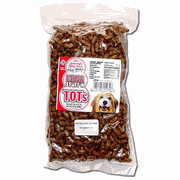 Training treats are also known as the "primary reinforcer". After you click to mark a certain behavior you desire the treat or reward must always follow. If you find your dog's favorite treat or motivation he/she will do almost anything to receive one. My little Shih-Tzu Macy loves liver treats and small pieces of cheese. It's important to note that the use of a clicker and the treats is necessary when shaping a new trick but can be phased out when the time is right.
Training treats are also known as the "primary reinforcer". After you click to mark a certain behavior you desire the treat or reward must always follow. If you find your dog's favorite treat or motivation he/she will do almost anything to receive one. My little Shih-Tzu Macy loves liver treats and small pieces of cheese. It's important to note that the use of a clicker and the treats is necessary when shaping a new trick but can be phased out when the time is right. Target Stick:
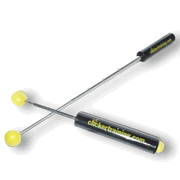 Target sticks are very handy for guiding your dog into the positions you want from them. This method is called "targeting" - it is a great way to build a wide range of cool tricks. You will also call upon "capturing", "shaping" and "luring" in your trick training sessions - don't worry you don't need to understand these terms yet.
Target sticks are very handy for guiding your dog into the positions you want from them. This method is called "targeting" - it is a great way to build a wide range of cool tricks. You will also call upon "capturing", "shaping" and "luring" in your trick training sessions - don't worry you don't need to understand these terms yet. General Rules To Keep In Mind When Teaching Your Dog Tricks
You will find more detailed and specific instruction within the text and videos provided for each individual dog trick. Below are a few general rules to keep in mind whenever you are doing some dog trick training:
- All dogs are different. There is no set way to teach tricks that will work for every dog on the block. It's up to you to discover what works best for your individual dog in regard to the motivation you use, length of training sessions and how quickly you progress through each new skill.
- When you start out training a new trick always keep it simple for your dog. Start out with an easy skill, in a familiar place to your dog and with no other distractions present. Then build the trick up piece by piece and add some distractions when you feel your dog is ready.
- Always provide clear, consistent and timely feedback to your dog. It's amazing how much your dog will look to you for cues and guidance. Ensure that you are relaying the right message to your dog and in a consistent fashion.
- Generally speaking you are better off not training tricks immediately after feeding your dog or when he/she is bursting with energy. It's ideal if your dog is in a somewhat calm state and ready to focus on the task at hand - I know, this is not easy!
- Always get the behavior (trick) you want your dog to perform first - then attach your cue or command to it. Not the other way around.
- No dog is too young or old for some fun trick training sessions. As long as your dog is not restricted by any health problems you can get started right now!
- Dogs don't generalize well. What this means in the context of trick training is that if you want your dog to perform his jaw dropping "roll-over" trick wherever you go, you must teach him how to do it everywhere you go.
- Some basic obedience training is helpful before you begin to teach your dog tricks. Apart from helping the trick training process, obedience training is vital for your dog's safety and well-being.
Dog Tricks - Written Instruction & Video Examples
Getting Ready For Tricks
| Charging The Clicker | Introducing The Target Stick |
Cool Dog Tricks!
| Spin Dog Trick | Take A Bow |
| Beg | Play Dead |
Dog Grooming Basics - All You Need To Keep Your Dog In Tip Top Shape
Simple or Stylish - a Complete Nose to Tail Makeover
Go to "Dog Grooming At Home Study Guide"
It is believed that as far back as 100,000 years ago, the wolf’s DNA differentiated itself from the dog’s. Whether this occurred as a turning point in the evolutionary timeline, or as a result of man’s hand is unclear. What is clear is that the idea of a domesticated canine following man’s footsteps is no new concept.
One study suggests that all dogs alive today are descendants of 3 Chinese bitches, who lived 15,000 years ago. Shall we say, the 3 Eves of dogkind?
Additionally, a human was found buried with his dog in Germany. Both bodies dated to 14,000 years ago. And, the oldest bones of a companion dog found in North or South American have been unearthed in Utah – and that little fella is believed to be 11,000 years old. Basically humans and dogs go way back, and it's easy to see why...
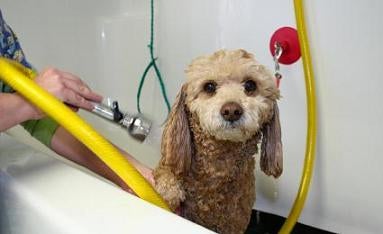
The History of Pooch Panache
Now that we’ve touched on Dog History 101, the question remains: If domesticated dogs have been around since about 12,000 B.C., when did humans begin to practice dog grooming? Did cavemen set up shop in fissures and barter puppy clips? Not likely. The first instance is surely not documented. Maybe it consisted of matted patches of fur cut with a sharpened whale bone, or yeast-filled ears cleaned with a cloth woven from animal fur?
What we do know is that documentation and depictions of dogs serving as princes and princesses of their owners’ castles exist as far back as 4240 B.C. And, as you may imagine, they were not akin to Tramp. I’d bet they were more the class of Lady!
In 17th Century France, the poodle became the official dog of Louis XV’s court, awarding her the rags-to-riches term “French Poodle”. Many of the do’s that the poodle donned long ago still live today – in the Continental and English Saddle clips. Around that same time, Terriers were considered to be prettier when their coats were trimmed of excess wiry hair.
In the 19th Century, the first documentation of how-to grooming guides serves as evidence of washing, trimming, and general maintenance of the aristocratic dog. Paintings from that same period depict both a lady shearing her companion, and a professional performing the same in a village marketplace.
No matter the exact point in time when professional dog grooming was born, we can all agree – it’s been a doggone long time. Our own hairstyles have changed – from the powdered wig to the mullet to the stacked bob. Our fashions have evolved from buffalo hides to hoop skirts to leg warmers to low-rise jeans. But one glance at a dated depiction of man and his best friend will reveal that dog style has changed little. In fact, if you look hard enough, you’re likely to find a painting of a man wearing a beaver fur hat and a frock coat, accompanied by a little Yorkshire Terrier that eerily resembles your own little Yorkie.
Dog grooming is an art that has spanned centuries – and one that has never gone out of style.
Grooming not just for High-Class Citizens
Is your dog a high-maintenance diva, or a scruffy, low-maintenance tough guy?
Regardless of whether your buddy sports bows and braids, or burrs and a funky odor, a few grooming practices are mandatory for the maintenance of a dog’s health and happiness.
The Daily Brush is not a club into which only long-haired dogs are admitted. Brushing is necessary for controlling shedding and stimulating blood flow. It also removes parasites, like fleas and ticks, from all lengths of hair. Stimulating the skin with brushing promotes proper oil distribution to the coat, which is essential to a shiny, healthy look and feel. It’s imperative that long-haired dogs are brushed daily, for resulting mats can be painful and dangerous to cut away.
Bathing your dog not only transforms him a more pleasant-smelling companion, but promotes skin health and a shiny coat.
Nail Trimming is more than a diva’s pedicure. Nails that are too long can curl into the dog’s pad and cause pain and result in infection. They can split, causing the same kind of pain that your own split nail would cause. Additionally, too-long nails can cause toes to spread, resulting in lameness, poor posture, and joint pain. And yes, long nails hurt you...and your furniture.
Tooth Brushing offers more benefits than the obvious. In addition to curbing doggie breath, it stimulates blood flow to the gums, removes plaque and tartar, and prevents gum (periodontal) disease. Your dog’s teeth are important – because to date, effective doggie dentures have not been patented.
Ear Cleaning is especially important for our floppy-eared friends. If you’ve ever had a dog with an ear infection, there was no denying it. Between the smell and the head-shaking, it’s more than obvious. Floppy ears promote the build-up of wax and the growth of sinister villains like bacteria, fungus, and yeast, which can lead to infection, itching, pain, and further complications if not treated.
Clipping is essential for certain long-haired breeds, to prevent mats and skin problems.
Other grooming musts occur on a case-by-case basis. For instance, if your dog is sprayed by a skunk, has hot spots, or is hosting a flea circus, auxiliary procedures are necessary to return Spot to normal.
It’s important for either you or a professional groomer to perform, at a minimum, the above procedures to stay abreast of your dog’s health – to spot lumps or lesions, and remove harmful parasites.
Every dog deserves basic grooming. Just as you know the importance of daily bathing and grooming for yourself, you should now understand that a dog’s level of health can be in direct proportion to the amount of grooming attention he receives. When you groom your dog, you’re offering a service that wolves shower upon one another, daily. When pack members groom one another, they are not only removing insects and other harmful elements from one another’s fur, but they are strengthening the pack bond.
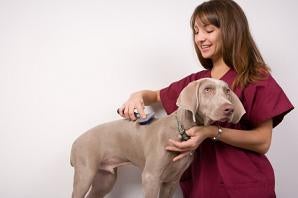
Ready...Steady...Groom!
I’ve got to be honest with you – if I was expected to stand still while a stranger came toward me with sharp objects, buzzing appliances, and strange-smelling concoctions that I’d never before encountered, I would be nervous, to say the least. But, having my own hair cut and styled is no big deal. Why? Because I’ve been conditioned to understand that there is no threat, either from the barber or from the tools she uses. If I had been raised in a commune where haircutting was forbidden, and was then released into the civilized world, my first haircut would be a traumatic event. Who knows? I might bite someone – and I’m not even a dog.
Helping your dog to embrace these same notions at an early age is imperative if you intend for him to have a pleasant grooming experience.
Start as soon as you bring the dog into your home. He can never be too young or too old. Introduce basic commands (stand, sit, stay, lie down, paw) and make common practice of massaging, brushing, poking, and picking at your dog. Open his mouth and introduce a toothbrush donned with poultry or beef flavored toothpaste. Spread his toes and wiggle your finger in between his pads. Lift his ears and lips. Take his collar off and back on again.
Why? Imagine this. If you were never hugged, kissed, touched, or patted on the back, you might be suspicious of the first person that approached you in such a manner. If hands were never laid on you, except for punishment, you might be inclined to defend yourself against any advances. That’s how a dog that hasn’t been introduced to touching will feel about his groomer – whether it’s you or a professional. Make it fun – teach your dog to revel in the attention.
Start early to properly socialize your dog. Take him to the park, to stores that allow pets, to friends’ houses that have children and pets. When a dog is introduced to a situation early, with no negative effects, he will trust similar situations throughout his life. Again, imagine if you were holed up in a house with the same people for all of your life, never coming in contact with anyone in the outside world. When you finally meet outside people, your reactions would likely be much different than those of a person who’s become accustomed to socializing. Your dog will naturally be suspicious of people if he hasn’t come to learn that there are lots of them and most of them are harmless. The last thing you want is for your dog to assume that his groomer is going to harm him. That will result in anxiety for the dog and possible injury to the groomer.
Obedience classes are a wonderful way to familiarize your dog with other animals and people, and to teach him basic commands that will be helpful during grooming.
Introduce your dog to running water and a sink with warm water in it. If you plan to wash at home, use the sink that you will do it in. If you plan on using a professional groomer, at least the dog will be trustful of the sound and feel of the water.
A spayed or neutered animal is always calmer, and less prone to anxiety and biting.
When the day finally comes for your puppy or dog’s first grooming appointment, drop him off and leave quickly. Assurance from you sends a message to the dog that there’s something to worry about. Likewise, if you’re planning on doing the dog grooming yourself, maintain a light and playful attitude. Reassuring your dog through the process may serve to raise his anxiety level – and yours. Don't make a big deal of it.
Be sure to inform your dog’s groomer of any health issues, not only those which you deem relevant to the grooming procedure. Also, be sure that your dog’s vaccinations are current before his first grooming appointment.
When to Heed the Dog Groomer Rumors
As with choosing your own hairstylist, looking in the yellow pages isn’t the recommended method. You could find yourself contracted with Edward Scissorhands, or the last man on earth that still embraces the mullet.
Likewise, the yellow pages and strip mall signs are not good methods for quality decision making. Compile a list of potential groomers and visit each one, taking the following factors into consideration. When choosing your dog groomer consider these important elements:
- Cleanliness: Does the staff clean up after each dog’s procedure? Are cages kept free of urine and feces? If the smell in the facility is offensive, I would assume the service to be the same. When you patronize a substandard grooming facility, you risk the infection of your dog’s skin...or worse.
- Humane Treatment: Are the animals in the groomer’s care treated with a nurturing and patient manner? Are the handlers gentle? Are dogs and cats housed in separate areas? Are cages large enough to accommodate the animals in them? And are dogs under automatic blow dryers monitored to prevent burning? If, during your visit, the staff at the facility does not seem to be enamored with their furry clients, then imagine how they treat them while not under your scrutiny.
- Good Lighting and Organization: Is the facility well-lit? Are work areas well-spaced and organized? If more than one groomer works at a time, does each one have sufficient space to move around his or her workspace? If the groomer is cramped, expected to operate with substandard equipment, or under insufficient lighting, no one can honestly expect the results to be dynamic.
- Finished Product: Visit during regular business hours so that you can assess the quality of the hairstyles exiting. Would you be satisfied if your dog were donning the same quality? Crooked cuts and skin nicks are good reasons to cross a groomer’s office off your list.
- Particular Breed Results: If your dog is of the Terrier persuasion, do not make a decision based on a Golden Retriever’s bath and clip. Some groomers specialize in particular breeds, and likewise, some shy away from certain breeds because they do not have the experience or the desire to perform a certain style. Be specific about your dog’s breed and the clip style that you fancy. Ask for pictures, and decide for yourself.
- Vaccinations: Choose a groomer who requires all canine clients to sport vaccination records – like Rabies and Bordatella (Kennel Cough). This will protect all animals, including yours, that share a space while in the facility.
- Familiarize Yourself: Take a few minutes to ask the manager or staff questions involving time required for a visit, appointment availability, cost, pick-up and delivery procedures, and complete services offered.
- Tranquilizers: If your dog is of the anxious sort, and will require a tranquilizer for his appointment, ask your groomer if they will administer it. Many will not (unless they’re affiliated with a veterinary office), but will accept an animal that has been tranquilized by a veterinarian and transported to the groomer’s office.
Additionally, network with your dog’s veterinarian, kennel, pet supply retailer, breeder, and pet-owner friends for recommendations. Clients who have had a bad experience will talk – and so will those who’ve been satisfied. Rumors travel fast – but so does a good word about a quality product.
You can expect to pay $40 to $60 for your dog’s visit to a professional groomer. Of course, that price can vary. Urban locales tend to be pricier. Mobile dog grooming services’ prices are a bit higher, but so is their convenience factor. And, of course, heavy matting and complex cuts will add bucks to your bill.
Whether you chance the groomer-next-door, or travel three towns south, a finicky attitude is central to grooming success.
Get a Dog Clip without making the Trip
Trekking to the dog groomer can be difficult for some folks. Namely seniors, the disabled, and those with limited available time to do so. Additionally, some dogs fall victim to car sickness or are just too aged or ill to withstand the trip. For any of these difficult situations, there is an answer – Mobile Dog Grooming.
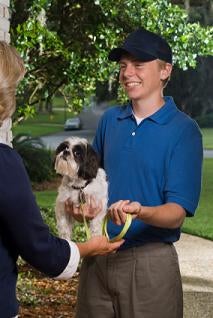
Mobile dog grooming offers convenience in a busy world. The difference in price from stationary facilities might just be justified with the amount of gas and time that you save. Housed in vans or trailers, mobile dog groomers will perform full service dog grooming right outside your home. You’re simply responsible for providing a legal parking space. The grooming is performed right under your muzzle, so you can be sure that procedures are performed to your high standards.
Moreover, your dog is king of the mobile groomer’s office. He’ll have the entire facility to himself. That means no sharing of parasites or illnesses, or animal kingdom tussles with other questionable characters.
Mobile groomers also come in handy when you’re out of town with your pooch. You no longer have to search for a groomer’s office. They’ll come to your hotel or resort and pamper your beloved. So why make the trip?
Dog Grooming at Home – Keepin’ it in the Family
Considering attending to your dog’s hygiene needs at home? Consider this: When you work your dog’s skin and remove foreign objects, you’re mirroring a portion of his natural, wild heritage. Wolves do it for one another, and now you can use home dog grooming, not only as part of a money-saving routine, but as a vehicle to bond with your best bud. He will repay you with heightened loyalty and extra wet kisses.
Just ten minutes per day spent doting on your doggie’s physical condition will result in a stronger bond and a mutual respect.
You may want to shoulder all hygiene needs at home, or just a portion. Here, you’ll find a menu of standard services offered by professional dog groomers (or, you). Keep in mind that if you choose to take care of your dog's grooming needs at home, you will be required to purchase a few dog grooming supplies to get you up and running.
Brushing:
Fur, that is - We’ll Touch on Teeth Later
Daily brushing is necessary for every dog, regardless of fur length. True, longer hair is more prone to mats and tangles, but brushing your short-haired dog stimulates blood flow and oils, and importantly, alerts you to any changes in his skin condition.
If, while brushing, you notice sore spots, itchy skin, or a notably dull coat, consider your dog’s overall health. If his latest veterinary check-up has proven him to be free from disease, consider changing his diet. Higher quality dog foods are sometimes the answer. Also, the addition of fatty oil to his diet can clear up skin conditions quite effectively.
Also note that parasites in your dog’s fur can transfer disease and can take a leap from the dog to you or your family members.
Black specks on the dog’s skin are a sure indicator of the presence of fleas. Run a flea comb through the hair and put your finds into soapy water to kill them. A flea-killing shampoo should be used during your dog’s next bath (start at the head when washing, to avoid a flea stampede into the dog’s ears).
If a tick is found crawling, pluck it and plunge it into rubbing alcohol to kill it. If the tick is imbedded in your dog’s skin, use tweezers to grasp its head, as close to the skin as possible, and pull it straight out, at a 90 degree angle to your dog’s body. Do not use substances like petroleum jelly or dish soap to force the tick to back out of the dog. This could stress the tick and cause it to regurgitate its contents back into Fido. Yuck! Also, do not attempt to kill the tick before pulling it. If you do, you will be left with a half-tick whose jaws are clamped into the skin – making it nearly impossible to remove. If you pull the tick and the head remains in the dog’s skin, swab the area with rubbing alcohol, and the skin will likely naturally push the head out, or the skin will grow around it. Consult with your veterinarian if the area becomes inflamed or red.
Examine your dog for burrs, seeds, thorns and other foreign objects while brushing his fur. Remove any that you find. Check between his pads for those same types of objects. Cuts and irritations from any of these can cause infection and numerous other complications.
Tools needed for brushing depend greatly upon your dog’s coat length. Long-haired dogs are going to require the most maintenance, and the greatest number of grooming tools. You’ll need an oil-based conditioner or detangler, a pair of scissors or a mat razor, a fine toothed comb, a wide toothed comb, a pliant wire brush, and a mat comb. Coats that sport tresses of significant length are pleasing to the touch and the eye, but require an extra shot of maintenance. Mats are common, and must be removed – either by combing or cutting. If left intact, mats will tighten until the dog’s skin is pulled and his movement inhibited. Severe pain and infection can result.
Dogs with a medium length coat can get by with a soft brush for most spots, and a comb for longer, feathered areas.
Short coats, which are all the rage this season, require little hair styling, but stimulation and examination are still necessary. A terrycloth rag or hound glove with massaging nubs work perfectly.
Brushing your dog daily aids in eliminating future problems and gives both of you a special time to look forward to. Read on for a better understanding of the construction of your dog’s coat and to learn about where all of that extra hair is coming from!
The Anatomy of a Dog’s Coat
Collar, Bodice, Hem
To better understand why your dog is carpeting your house with fur, or why you must dodge tumble furweeds to make your way from room to room, let’s discuss the construction and function of the coat.
Dogs that shed seasonally (or year-round) have double coats. That is, a top coat and an undercoat. The top coat is what you see. The shiny, coarse guard hairs protect the dog by repelling water, sun, and other unwelcome contaminants. If you find a hair in your house that looks much like the others lying about, but is longer, tapered at the end, coarser, and thicker, you’ve recovered a guard hair. These guard hairs are shed only once per year.
The undercoat is composed of a more downy hair, and is usually what you find in your dog’s brush. In most climates, the undercoat dies twice per year. The length of daylight triggers a hormone within the dog’s system, which in turn triggers this function. Other circumstances may dictate heavy shedding. Bad nutrition, poor general health, whelping, recent x-rays, surgery, or the administering of anesthesia may cause your dog to present uncharacteristic shedding.
You can expect a normal shedding cycle to last for three to eight weeks. Some breeds, and some dogs that live in areas with irregular daylight patterns, may shed year-round.
You can control your dog’s shedding with the addition of a fatty oil into his diet and regular brushing and bathing. Or, collect it and make a sweater.
Singled-coated dogs, like poodles and some terriers, do not shed. Their hair is more like ours. It keeps growing...and growing...and growing. Single-coated dogs make up a large portion of dog groomers’ clientele for this reason.
Bathing
That Coat is not “Dry Clean Only”
You should bathe your dog about once per month. More frequent bathing could cause drying of his skin. Sometimes, a veterinarian will recommend more frequent shampooing, but will also probably prescribe special shampoo that contains Aloe Vera or another specific medication for your dog’s specific skin problem. Conversely, bathing that’s done too infrequently can leave your dog with an excess of oil, mats, and a bad smell. Use a canine-specific shampoo. Human shampoo has the wrong pH level, and will leave Fido with skin problems.
Have everything you’ll need for your dog’s bath by your side – before beginning. If you’re halfway through the bath and realize that you’ve forgotten the towel, you’ll be in a pickle, to say the least. Have a washcloth, dog wash, and a towel available. Remember any extras, too, like treats or conditioner.
Start by brushing the dog and removing any mats. Place him into an empty tub or sink and add a few inches of warm water, slowly. If the rising water puts Pooch into a panic, use a detachable shower head in a dry tub. Use a light spray or a cup to wet his fur, avoiding his head. Lather, using your fingertips to massage the skin, while taking the time to feel for any lesions, bumps, or parasites. Avoid the eye, ear, and face area while lathering. Most dog soaps aren’t tear-proof.
Be sure to thoroughly rinse the soap from Rover’s fur, or he could be left with itchy skin and a dull or sticky coat.
After he’s rinsed, use a wet washcloth to wipe his face and the insides of his ears. If you're lucky, you’ll get him out of the water before the great shake. A towel placed over his head may help to delay the inevitable while you transfer him to a shake-friendly zone, but always be alert – you could be plastered at any moment.
Workin’ at the Dog Wash. Workin’ at the Dog Wash, Yeah!
What? You don’t enjoy chasing your dog with the hose? Or wiping hair from the bathtub? Or cleaning up after your dog shakes and plasters your home décor with soap, hair, and dog-scented water? Well, you’re not alone.
Enter the Self-Serve Dog Wash.
Self-serve dog washes exist for much the same reason as car washes do. You might enjoy the convenience of a car wash – no unwinding and rewinding of the hose, endurance of low water pressure, or searching for elusive supplies. You can drive into the car wash, do your business, and leave in a matter of minutes, without the headache.
Today’s self-serve dog washes come equipped with all the dog grooming supplies you will ever need including large tubs, sprayers, drains, lead clips to keep Fido in place, dryers, shampoo, and other amenities that vary by location. Some are operated in conjunction with a grooming business, while others are truly self-serve, coin or bill operated, 24-hour facilities.
If you’ll be workin’ at the dog wash, try to plan your trip on a weekday, to avoid a long line of dirty doggies.
You can expect to pay from $10 to $20 per wash. If you have a large dog, a hairy dog, or a dog that likes to...let’s say...express himself during baths, it just might be more than worth it.
Ear Cleaning
Huh? Whadya Say?
Any dog can fall victim to ear problems, but our floppy-eared friends, especially those that swim, are the most susceptible. Why? Because most of the nasties found in a dirty dog ear flourish in damp, dark places. Bacteria, yeast, and fungus like to live with the curtains drawn.
We’ve discussed that ears should be cleaned with clear water and a washcloth during bath time, but it’s also important that ears be checked and cleaned weekly. Wax buildup can lead to population of the sinister villains mentioned above, and can in turn breed a nasty infection, or even a hematoma resulting from all of the dog’s head shaking.
The best indicator of a problem in your dog’s ears is a nasty smell. And believe me, once you smell it, you won’t forget it. Couple that with head shaking, and you’d be wise to get on the phone with the veterinarian.
Your dog’s ears should be inspected every week for sore spots, foreign material, and excessive build-up of any substance.
How to prevent infections? Keep those ears clean.
Start with an ear wash specially made for canines. If your dog has a history of ear infections, his veterinarian may prescribe one that contains a drying agent. Wet a cotton ball and wipe out the inside of the ear flap. If your dog wants to shake, allow him. This will help to loosen the wax and expel the excess fluid. Use a Q-tip to clean the valleys inside the ear flap, but do not insert either the cotton ball or the Q-tip into the canal. You may see the veterinarian do this – but as with any stunt – do not try this at home.
If your dog’s ears sport their own hairdos, they will need to be trimmed before cleaning. Never pluck or trim hairs deeper than half an inch into the canal. Hair removal will allow you to see any abnormalities, and to more effectively clean the ear. Once again, ask your Vet if you have any concerns.
Nail Trimming
Pedicures not Reserved for the Prim
Many pet owners shy away from cutting their own dog’s nails, but if you know what you’re doing, it’s not just a breeze – it’s a wind storm. You may have heard nightmare stories of owners who have cut the quick of the nail and been plagued with flowing blood and a distressed dog for days. Okay, maybe they’re being a bit dramatic, but we’ll go with it. Here, we’ll discuss how to know where the quick starts. We’ll also cover what to do if the quick is cut.
A number of nail cutters are available, including the guillotine and pliers types. The guillotine, or Resco, style is constructed much like a cigar cutter, and the pliers...well, like a pair of pliers. A file or rotary tool designed for smoothing rough edges after the cut can be used...if you can get your dog to sit still that long. Sharp edges normally wear down on their own within a few days. A walk on concrete or blacktop does a great job of this.
It’s recommended that nails be cut every 2 to 3 weeks, to avoid complications from overgrown ones, like split or ingrown nails, and even lameness.
The quick is a bundle of blood vessels and nerves. And it has the potential to quickly complicate your dog’s pedicure experience. If the quick is cut, it will cause your dog a great amount of pain, and the bleeding can be difficult to stop.
If your dog is lucky enough to be blessed with light-colored nails, the quick is visible as a dark or pink area that runs up the center of the nail. Its end is obvious, and that’s important, because you don’t want to cut into it. For these fair beauties, nail cutting instructions are simple: Cut the nail at a flat 90 degree angle, 2 mm from the end of the dark-colored quick.
More common dark nails are more complicated to cut. The quick is not obvious, so it’s best to snip small amounts of the nail at a time, rather than all in one slice. With every cut, look into the interior of the nail. With the first snip, you’ll see the light-colored core of the nail. Cutting into this part is not painful. Continue until a second interior, gray or pink, area is visible. This is the beginning of the quick, which means...quick...stop cutting! Ideally, you’ll want to cut the nail 2 mm from this area in the future, and the more often you cut Poochie’s paws, the more familiar you will become with his unique nail anatomy.
What to do if the quick is nipped? First, there will be no mistaking the cut. Your dog will let you know. Second, understand that it’s not uncommon for an injured quick to bleed rather profusely. If it happens, don’t panic, and cover the bleeding with a towel. Then submerge the nail into a cup of flour or cornstarch, and keep it there for a few minutes. This should slow or stop the bleeding. You may rinse the excess cornstarch or flour from the dog’s paw with warm water. Other commercial products, such as styptic pens, quick-stop, clotting powders, and clotting solutions are also available. Bleeding should stop within 10 minutes.
It’s important to be cautious and precise when trimming your dog’s nails. If a quick is cut, he may be shy about having it done again. Any dog will naturally be anxious about the whole process. If you introduce him, as a puppy, to paw-handling and the tools you will use, anxiety will be reduced and he will have a quick and successful pedicure. If you're nervous about trimming your dog's nails you can always take him to a professional groomer. After watching a professional carry out this procedure a few times, you will most probably be ready to give it a try yourself.
Toothbrushing
That Stink Means More than you Think
Have you ever fallen victim to the dreaded “dog breath” of the canine kingdom? Much like doggie ear odor, if you smell it once, you’ll never forget it. Brushing of a dog’s teeth should not be used simply as a remedy for halitosis, but as a preventative measure. By the time Fido’s breath is bad enough to make your flowers wilt, he’s probably already developed periodontal disease, which affects not only his dental health, but his other major body functions. When infection sets into the gums, Spot’s antibodies rush to the site, allowing other conditions throughout the body to exacerbate.
Daily toothbrushing really does deliver when it comes to maintaining your dog’s health. And, it’s relatively easy to get your dog to submit. Meat flavored toothpastes make it seem more like a treat than a chore.
First day - offer the dog a little bit of the toothpaste on your finger. If he likes it – great. If he doesn’t like it, passify him with a treat that he does love and buy a different flavor of toothpaste tomorrow.
Second day – apply a small amount of a toothpaste that he loves to your fingers and explore the inside of his mouth. Rub his front teeth and gums. His tongue will likely be going crazy, chasing your fingers and making it difficult to get to his teeth, but this is a great sign. It should tell you that he’s having fun with the flavor, and not stressing about the fact that someone is brushing his teeth.
Third day – use a toothbrush, finger tip brush, or dental sponge to rub the toothpaste onto the teeth and gums. Start with a few teeth at a time, and increase the number every day, until you’re brushing the exterior of every tooth every day. Concentrate on the outside of the teeth, especially at and under the gum line. Applying the toothpaste to the teeth’s surfaces is more important than a scrubbing action. The enzymes in the paste will work on the plaque without intense scrubbing.
Go ahead. Give kisses. Share biscuits. With poultry-clean breath, your dog will be as fresh as a spring morning. And you can rest, knowing that you’re completing an important step in the maintenance of his overall health.
Clipping
From Hurly Burly Curls to Short and Simple Merles
As with any quality job, the finished product is usually in direct proportion to the quality of the tools used. A superior, high-speed dog clipper is a must, especially for those dogs that have a heavy, or heavily matted, coat.
Nearly as important is the maintenance of those quality dog grooming tools. Before using your new clipper, oil the blade with a blade oil recommended by the manufacturer. General use products, like WD40 or petroleum jelly will leave you lamenting the loss of your new investment – don’t give into the temptation.
Clean your clipper’s blade after every cut. Can-of-air or a compressor hose works nicely for blowing dirt and hair from the crevices. Or, a stiff-bristled paint brush works, too. After cleaning the blade, oil it, wrap it in a cloth, and place it inside a plastic bag. This will prevent rust and corrosion of the blade. Either of these villains will warrant a new blade purchase – negating your home grooming money-saving efforts.
Clipper blades should be sharpened every few cuts by a professional, in order to keep your dog’s hairdo clean and cut to precision. You can find one in the yellow pages under “sharpening”. Attempting to sharpen the blade at home never ends well.
Always bathe and dry your dog before clipping. Dirt, powders, and foreign objects can destroy a clipper blade and compromise the quality of the finished do.
Blade cuts range in length from 1/125” to 5/8”. In other words, you can strip your dog bald or give him an all-over trim. You can experiment with different blades to create a unique look that will be next year’s rage, or keep your dog in uniform with a cut described by his breed standard. Skip tooth blades work well for a quick, coarse cut, and for the removal of a mass of hair or “unwelcome mats”. Full tooth blades offer a smoother, finished look. They cut more slowly, and are generally used on shorter hair, or as a finisher after the skip tooth blade. Blades are classified by numbers. The higher the number, the shorter the resulting haircut will be. For instance, a #9 will cut the hair to 1/16”, while a #4 will cut the hair to 3/8”.
Most breed standards dictate a standard clip, necessary for showing, and sometimes adhered to, well...just because it looks spiffy. For instance, your Irish Terrier’s standard calls for a #5 blade for the body and tail, and a #10 on the head, ears and throat. Your West Highland White Terrier’s standard begs a #3-3/4 or #4 and scissors all over, and a #10 or #15 for the tips of her ears. If you choose to adhere to your breed’s standard clip, consult the breed standard and purchase the blades necessary for that particular cut.
Your mixed breed or other dog for which standards are not of any importance is only subject to your taste and your veterinarian’s recommendations. For instance, sanitary spots, like the genital and anal areas, are best clipped with a #10 blade. A #15 blade works well for hair between foot pads. Matted fur responds well to a #5 - #7 blade, with #7 being best for the worst mats. Dense coats will require a minimum of a #7 blade, and legs and the tops of feet will need little more than a scissors cut.
As a standard, face, foot, genital, and anal fur should be kept short for optimum health and hygiene. And, bear in mind that shorter fur dries faster and doesn’t mat. Just a friendly hint.
Not every dog will need clipped. Short to medium-coated dogs, like Dalmations and Labradors require little or no clipping. While others, like the Shih-tzu or Silky Terrier can turn into unrecognizable bush boogies if neglected. Looking cute is great, but foremost, remember that an unkempt coat can lead to painful “unwelcome mats”, or worse.
Finding the Perfect Dogstyle
My barber displays a plaque on her mirror that says, “I’m a Beautician, not a Magician.” I can’t help but think that the same principle applies to our dogs’ hairstyles. You’re not going to be able to make your Rottweiler look like Rod Stewart, but you might be able to make your Terrier look like Tina Turner. Bows and beads don’t belong on a Golden Retriever, but will smarten the look of your Shih Tzu.
The number of dogstyles available is dizzying. For instance, a poodle’s traditional Lion Trim (the only clip allowed for showing) comes in four different varieties: The Puppy Clip, the Continental Clip, the Modified Continental Clip, and the English Saddle Clip. I would suggest that you research the standard clips available for your dog’s particular breed.
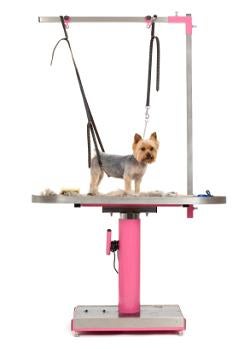
Here, I’ve listed a few of the most common dogstyles. The list is far from exhaustive. Your groomer or a good dog grooming book can guide you through a more comprehensive list of styles.
Show clips vary by breed and are generally the most intricate. If you plan on showing your dog under any of many organizations, his look will be subject to particular standards. Advise your groomer of any special requirements. An experienced, knowledgeable dog groomer will know exactly what you’re looking for.
The puppy clip is generally about 1½“ all over, but can be adjusted to your taste. Many pet owners find it practical and easy to manage. It allows for plenty of dog activity and prevents matting.
A utility or kennel clip is accomplished by using a #5 or #7 blade over most of the body for a resulting 1/16” to ½” coat. The face, head, and tail are hand- scissored.
For the fluffy look, a teddy bear clip is recommended. This completely scissored style is ½” all over.
Lamb clips are accomplished by cutting the midsection and neck to ¼” to 3/8”, while scissoring the head, legs, and tail. When finished, the midsection dons the shortest fur, and the legs sport the longest hair.
Hand stripping is a technique in which the groomer uses a stripping knife to remove dead hair from single-coated breeds, improving the look of their natural coat.
And finally, there’s the creative cut. For this one, use your imagination (or give your groomer liberty if you feel completely comfortable with his or her ability). Use colors, braids, gems, beads, shaved and scissored areas to punk out or primp up your dog.
Whether you choose to fashion your dog in a break-out style, or keep him in uniform so that his friends don’t pick on him, the choice is up to you. Keep his hygiene at the forefront of your mind, and the rest is only as limited as your imagination.
Dog Grooming - Get Schooled
Interested in turning your love of dog grooming into a career? Want to make over Mountain Dogs or beautify Bishons? The good news is that it’s more attainable than you may have imagined. And the most important job requirement? An extraordinary love for our four-legged friends, coupled with a desire to contribute to their hygiene, health, and happiness.
The first, and most simple, way to introduce yourself to dog grooming is to search out an apprenticeship. Visit the dog grooming facilities in your area and speak to the owner or manager about a job. In most states, you can do this at the tender age of 16, or even earlier with an Early Worker’s Permit.
You can earn a dog grooming certification or a degree online. A groomer’s certification will help you to attain an apprenticeship, while a diploma affords you the right to own and operate your own grooming shop. If you choose to surf the web and jump onto the virtual bandwagon, consider the limitations. Potential employers may not smile brightly upon a certification or diploma obtained in this manner, and you’re going to have a bit of trouble finding test subjects. This might, however, be a good option if you’re already employed as an apprentice at a grooming facility, and simply looking to earn your certification or diploma.
There are currently 52 state-licensed dog grooming schools in operation in the United States, offering instruction with live instructors and real dogs (as opposed to online courses). Each school offers programs that range in duration from 2 to 18 weeks with both written and practical exams, through which students are given the opportunity to earn the title of “National Certified Master Groomer”. If you’re hoping to own a business and oversee other groomers in the future, this particular certification will prove invaluable.
Your first job, without certification, in a groomer’s shop will likely be as a dog bather, and you will probably make $7 to $10 per hour. In the next step up, as assistant groomer, you can expect to make $10 to $15 per hour, and then $25 per hour as a master groomer.
Make Dog Grooming Great!
Whether you decide to employ a professional groomer, perform your dog’s grooming at home, or take the steps to become a profession groomer yourself, enjoy it. If you see grooming as a chore so will your dog. Make it fun for Fido, and you’re going to have fun, too.
To purchase your dog grooming supplies online please visit my store - Dog Grooming Supplies For Sale.
The http://www.dog-obedience-training-review.com














